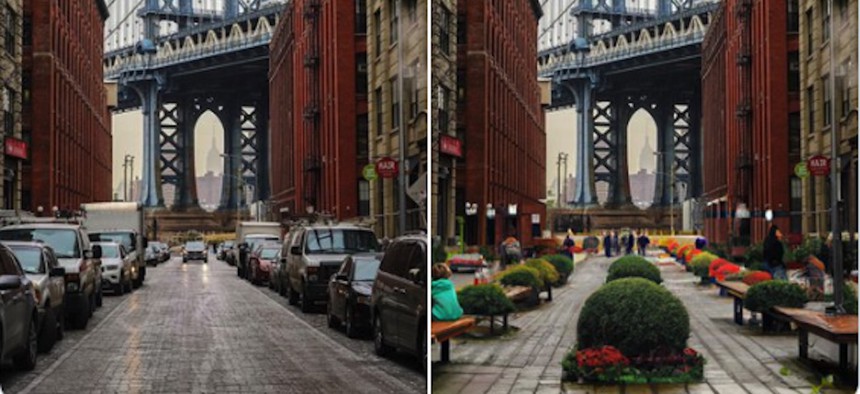Urban spaces get an AI makeover

Two images show Washington Street in Brooklyn, New York, as it currently stands (left) and how it would look with a walkway and park benches according to a DALL-E rendition. Image courtesy of Zach Katz via Twitter: @betterstreetsai

Connecting state and local government leaders
The Dall-E artificial intelligence system is helping redesign city streets, replacing car-centric roads with walkable boulevards and bike lanes.
Prospect Park sits just four miles away from one artist’s Bushwick apartment in Brooklyn, New York, but with no safe bike lane to get there, Zach Katz has to spend nearly an hour on the bus or subway to get there. Imagining a more walkable New York, he digitally redesigned the busy city streets to create an urban environment that puts pedestrians and cyclists first.
Katz, a 28-year-old artist and urban design advocate, is leading Transform Your City, a team of activists, planners, developers and researchers that uses Dall-E artificial intelligence to reimagine cities with more open spaces such as parks, car-free boulevards and bike lanes.
Digital recreations make it easier for city planners to envision potential projects that could ultimately facilitate safer street conditions, Zach said during the Route Fifty Future Cities summit. Dall-E is a machine learning model developed by research lab OpenAI that can produce realistic cityscapes from text and image prompts. While renditions may not look as realistic as professional designs, the rapid pace of AI advances may enable Dall-E to catch up to professional planners, he said.
Dall-E can realize an image in 20 minutes for a dollar or two, reducing the cost and time it would take for staff to do the same job, Katz said in an email. Officials from Sheboygan, Wisconsin, and New York have requested AI transformations of city streets, he said.
“What would it look like if it were safe for a child to bike to the grocery store?” Katz said. “It’s hard to imagine this kind of total transformation, so the AI renditions are really helpful for that.”
The team is also developing a website to connect citizens, safe street advocacy groups and city officials who want to turn AI representations into reality. The Django-based site is hosted on Render, Katz said.
Residents looking for infrastructure changes commonly rely on ad hoc petitions and emails to their elected officials, Katz said, which can be a slow process. The website would allow users to request a street transformation at the click of a button and type out an idea to redesign a part of their city.
Requests would be shared with local street safety advocacy groups who can coordinate with city planners to create a design that fits well with the surrounding environment, Katz said. Once the AI image is rendered, it is uploaded to the site where people can vote for the images they like, making policymakers aware of which designs are most popular with the public.

The voting system can help elected leaders “feel confident taking these bold actions to create better streets knowing they have political support,” Katz said in the webinar. Some designs could be as simple as blocking off a part of the road with planter boxes and Jersey barriers, he added. By starting out with those temporary foundations, cities can gradually invest in better quality materials and infrastructure.
The team also includes Transform Your City Labs, a group that works with cities for consulting, planning and design purposes. It partnered with Goudappel, a Netherlands-based consultancy firm that offers expertise on urban planning, including cycling, road safety, mobility planning, urban development, traffic management, landscape architecture, behavioral science, parking and public transport engineering.
“Some urban planners joke about AI taking their job, but most are excited for it, because, in reality, it’s likely to make their job infinitely easier,” Katz said. “They can focus on creativity, coming up with ideas, creating beauty [and more], instead of menial things like writing reports (AI will eventually be able to do this) or tweaking things in Photoshop.”





